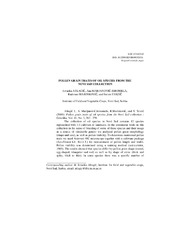Pollen grain traits of oil species from the Novi Sad collection
Osobine polena uljanih vrsta iz novosadske kolekcije
| dc.creator | Atlagić, Jovanka | |
| dc.creator | Marjanović-Jeromela, Ana | |
| dc.creator | Marinković, Radovan | |
| dc.creator | Terzić, Sreten | |
| dc.date.accessioned | 2021-04-26T18:28:07Z | |
| dc.date.available | 2021-04-26T18:28:07Z | |
| dc.date.issued | 2009 | |
| dc.identifier.issn | 0534-0012 | |
| dc.identifier.uri | http://fiver.ifvcns.rs/handle/123456789/662 | |
| dc.description.abstract | The collection of oil species in Novi Sad contains 12 species represented with 1-4 cultivars or landraces. In the continuous work on this collection in the sense of breeding of some of those species and their usage as a source of 'desirable genes' we analyzed pollen grain morphology (shape and size), as well as pollen viability. To determine mentioned pollen traits we used Axiovert 40C microscope together with a software package (AxioVision LE; Rel.4.3.) for measurement of pollen length and width. Pollen viability was determined using a staining method (ALEXANDER, 1969). The results showed that species differ by pollen grain shape (round, egg-shaped, triangular and rod) as well as by shape of exine (thick and spiky, thick to thin). In some species there was a specific number of apertures present (1-11). The size of viable pollen grains ranged from 29,10/12,58μ (coriander) to 176,63/169,94μ (oil gourd), while non-viable pollen grains were always smaller (27,27/10,97μ to 119,62/100,86μ) at the same plant species. Pollen viability of most species was around 80%. Lowest pollen viability was found in white flax (56,98%), and the highest in oil pumpkin (91,43%). | en |
| dc.description.abstract | Kolekcija uljanih vrsta u Novom Sadu raspolaže sa 12 vrsta zastupljenih sa 1-4 sorte, odnosno lokalne populacije. Za dalji rad na korišćenju ove kolekcije u smislu oplemenjivanja pojedinih vrsta ili korišćenje istih kao izvor 'poželjnih gena' ispitivana je morfologija polenovih zrna (oblik i veličina), kao i vitalnost polena. Za određivanje osobina polena korišćen je mikroskop Axiovert 40C, a za merenje dužine i širine polenovih zrna softver AxioVision LE; Rel.4.3. Vitalnost polena je određena bojenom metodom (ALEXANDER, 1969). Rezultati ispitivanja su pokazali da su se vrste razlikovale po obliku polenovih zrna (okrugla, jajasta, trouglasta i štapičasta) kao i po izgledu egzine (debela i bodljikava, debela do tanka). Za neke vrste je karakteristično postojanje određenog broja septi (1-11). Veličina vitalnih polenovih zrna se kretala od 29,10/12,58μ (korijander) do 176,63/169,94μ (uljana bundeva), dok su sterilna zrna bila uvek sitnija (27,27/10,97μ do 119,62/100/86μ) kod istih biljnih vrsta. Vitalnost polena kod najvećeg broja vrsta je bila oko 80%. Najnižu vitalnost polena je imao lan beli (56,98%), a najvišu uljana tikva (91,43%). | sr |
| dc.publisher | Društvo genetičara Srbije, Beograd | |
| dc.rights | openAccess | |
| dc.rights.uri | https://creativecommons.org/licenses/by-nc-nd/4.0/ | |
| dc.source | Genetika-Belgrade | |
| dc.subject | oil species | en |
| dc.subject | pollen grain shape and size | en |
| dc.subject | pollen viability | en |
| dc.title | Pollen grain traits of oil species from the Novi Sad collection | en |
| dc.title | Osobine polena uljanih vrsta iz novosadske kolekcije | sr |
| dc.type | article | |
| dc.rights.license | BY-NC-ND | |
| dc.citation.epage | 270 | |
| dc.citation.issue | 3 | |
| dc.citation.other | 41(3): 263-270 | |
| dc.citation.rank | M51 | |
| dc.citation.spage | 263 | |
| dc.citation.volume | 41 | |
| dc.identifier.doi | 10.2298/GENSR0903263A | |
| dc.identifier.fulltext | http://fiver.ifvcns.rs/bitstream/id/1507/659.pdf | |
| dc.identifier.wos | 000274566200005 | |
| dc.type.version | publishedVersion |


